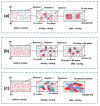Toughening of Epoxy Systems with Interpenetrating Polymer Network (IPN): A Review
- PMID: 32847125
- PMCID: PMC7564612
- DOI: 10.3390/polym12091908
Toughening of Epoxy Systems with Interpenetrating Polymer Network (IPN): A Review
Abstract
Epoxy resins are widely used for different commercial applications, particularly in the aerospace industry as matrix carbon fibre reinforced polymers composite. This is due to their excellent properties, i.e., ease of processing, low cost, superior mechanical, thermal and electrical properties. However, a pure epoxy system possesses some inherent shortcomings, such as brittleness and low elongation after cure, limiting performance of the composite. Several approaches to toughen epoxy systems have been explored, of which formation of the interpenetrating polymer network (IPN) has gained increasing attention. This methodology usually results in better mechanical properties (e.g., fracture toughness) of the modified epoxy system. Ideally, IPNs result in a synergistic combination of desirable properties of two different polymers, i.e., improved toughness comes from the toughener while thermosets are responsible for high service temperature. Three main parameters influence the mechanical response of IPN toughened systems: (i) the chemical structure of the constituents, (ii) the toughener content and finally and (iii) the type and scale of the resulting morphology. Various synthesis routes exist for the creation of IPN giving different means of control of the IPN structure and also offering different processing routes for making composites. The aim of this review is to provide an overview of the current state-of-the-art on toughening of epoxy matrix system through formation of IPN structure, either by using thermoplastics or thermosets. Moreover, the potential of IPN based epoxy systems is explored for the formation of composites particularly for aerospace applications.
Keywords: IPN; epoxy; mechanical properties; morphology; semi-IPN; toughening.
Conflict of interest statement
The authors declare no conflict of interest.
Figures











References
-
- Paul S. Manufacture of Organic Compounds Containing Basic Substituents. US2131120A. Google Patents. 1938 Sep 27;
-
- Castan P. Process for the manufacture of thermosetting synthetic resins by the polymerization of alkylene oxide derivatives. US2444333A. Google Patents. 1948 Jun 29;
-
- Yahyaie H., Ebrahimi M., Tahami H.V., Mafi E.R. Toughening mechanisms of rubber modified thin film epoxy resins. Prog. Org. Coat. 2013;76:286–292. doi: 10.1016/j.porgcoat.2012.09.016. - DOI
-
- Shih Y.-F., Jeng R.-J. Carbon black containing IPNs based on unsaturated polyester/epoxy. I. Dynamic mechanical properties, thermal analysis, and morphology. J. Appl. Polym. Sci. 2002;86:1904–1910. doi: 10.1002/app.11145. - DOI
-
- AJ K., Young R. Fracture Behavior of Polymers. Applied Science Publishers; London, UK: 1983.
Publication types
LinkOut - more resources
Full Text Sources
Other Literature Sources

